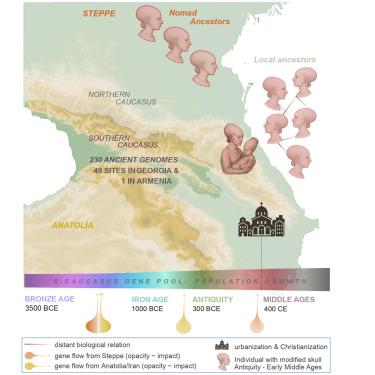The genetic history of the Southern Caucasus from the Bronze Age to the Early Middle Ages: 5,000 years of genetic continuity despite high mobility
IF 42.5
1区 生物学
Q1 BIOCHEMISTRY & MOLECULAR BIOLOGY
引用次数: 0
Abstract
The Caucasus was a hub for cultural and technological innovation in prehistory, yet the population history between the Greater and Lesser Caucasus remains insufficiently understood. We present genome-wide data of 205 individuals from modern Georgia and 25 from Armenia, spanning the period from the Bronze Age (BA) to the “Migration Period” (c. 3500 BCE–700 CE). Our results reveal a persisting local gene pool that, during the Middle-Late BA, absorbed additional ancestry from Anatolia and the neighboring Eurasian Steppe. In subsequent periods, we document population growth and increasing genetic diversity, supported by a high rate of individual ancestry outliers, particularly in urban centers of eastern Georgia. Among 20 Medieval individuals with artificially deformed skulls, 15 were part of local mating networks and five derived ancestry from the Eurasian Steppe, suggesting that cranial modification arrived with nomadic groups but became a locally adopted cultural practice.

南高加索从青铜器时代到中世纪早期的遗传历史:5000年的遗传连续性,尽管高流动性
高加索是史前文化和技术创新的中心,然而大高加索和小高加索之间的人口历史仍然没有得到充分的了解。我们展示了来自现代格鲁吉亚的205个人和来自亚美尼亚的25个人的全基因组数据,涵盖了从青铜时代(BA)到“迁徙时期”(公元前3500年-公元前700年)的时期。我们的结果揭示了一个持续存在的本地基因库,在BA中后期,吸收了来自安纳托利亚和邻近的欧亚草原的额外祖先。在随后的时期,我们记录了人口增长和遗传多样性的增加,这得到了个体祖先异常值的高比率的支持,特别是在格鲁吉亚东部的城市中心。在20个人工变形头骨的中世纪个体中,有15人是当地交配网络的一部分,5人的祖先来自欧亚草原,这表明颅骨改造是随着游牧群体而来的,但成为当地采用的文化习俗。
本文章由计算机程序翻译,如有差异,请以英文原文为准。
求助全文
约1分钟内获得全文
求助全文
来源期刊

Cell
生物-生化与分子生物学
CiteScore
110.00
自引率
0.80%
发文量
396
审稿时长
2 months
期刊介绍:
Cells is an international, peer-reviewed, open access journal that focuses on cell biology, molecular biology, and biophysics. It is affiliated with several societies, including the Spanish Society for Biochemistry and Molecular Biology (SEBBM), Nordic Autophagy Society (NAS), Spanish Society of Hematology and Hemotherapy (SEHH), and Society for Regenerative Medicine (Russian Federation) (RPO).
The journal publishes research findings of significant importance in various areas of experimental biology, such as cell biology, molecular biology, neuroscience, immunology, virology, microbiology, cancer, human genetics, systems biology, signaling, and disease mechanisms and therapeutics. The primary criterion for considering papers is whether the results contribute to significant conceptual advances or raise thought-provoking questions and hypotheses related to interesting and important biological inquiries.
In addition to primary research articles presented in four formats, Cells also features review and opinion articles in its "leading edge" section, discussing recent research advancements and topics of interest to its wide readership.
 求助内容:
求助内容: 应助结果提醒方式:
应助结果提醒方式:


